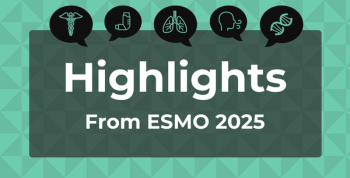
Defining Long COVID Symptoms; Lauren Wisk, PhD
The American Journal of Managed Care spoke with Lauren Wisk, PhD, about her recent study aimed at assessing various definitions of long COVID and how a standard definition might aid physicians in clinical practices.
Establishing a standardized definition for long COVID can reduce delayed diagnosis and record-keeping while improvingclinical practices.
In a recent study, the Innovative Support for Patients with SARS-CoV-2 Infections Registry (INSPIRE; NCT04610515) cohort, in addition to 5 other comparator studies, included both COVID-19–positive and COVID-19–negative individuals, the former of whom were symptomatic for other post-illness respiratory illnesses. The inclusivity addresses the similarities between long COVID, emphasizing the fact that not all post-illness symptoms assessed were exclusive to COVID-19.
Existing definitions of long COVID, pulled from studies largely composed of COVID-19 cases, were intended for that specific audience. The American Journal of Managed Care® spoke with the leading author, Lauren Wisk, PhD, assistant professor in the Division of General Internal Medicine and Health Services research at the University of California, Los Angeles, who acknowledged the tradeoff to the National Academies of Science, Engineering, and Medicine (NASEM) definition, which does not require laboratory confirmation for COVID-19 to identify with its long COVID symptoms.
Editor’s note: In the video above, Wisk referred to WHO instead of NASEM at 02:10.
“There are trade-offs there, and one of them is that we're potentially going to be misdiagnosing people as having long COVID when they potentially have some other condition, including persistent symptoms from another respiratory illness,” Wisk said.
The results yielded a lower sensitivity than specificity, making it difficult to identify a signal's optimal definition. These findings highlight the challenges of establishing a universal standard definition for diagnosing long COVID and underscore the need for definitions that better capture the full spectrum of post-viral symptoms across diverse respiratory illnesses.
This transcript has been lightly edited; captions are auto-generated.
Transcript
How did the INSPIRE cohort’s design, especially the inclusion of COVID-19–negative but symptomatic participants, shape your approach and findings?
I think this is one of the most interesting features of our study, that we were not just looking at COVID-19–positive individuals as a whole, or even comparing people with COVID-19 to people without who are otherwise healthy, but we were [asking], “Compared to other very serious respiratory-type illnesses, how does COVID-19 compare?” It's a really unique comparison.
There are not a lot of other studies that are able to sort of make those sorts of parallels, and I think what's really most interesting—and this is not just our study, but this more recent study that we published, for sort of the body of work that came out of this INSPIRE cohort—is that I think we were actually underestimating, for a lot of other respiratory illnesses, how many people had persistent symptoms after an illness, and maybe a little bit underestimating as well the potential for not long COVID per se, but in general, lingering symptoms.
When we look specifically at applying our long COVID definition to our COVID-19–negative cohort, there are still people in our COVID-19–negative cohort who would meet the definitions for long COVID. It suggests that they might be having these other lingering or persistent symptoms from a non–COVID-19–like illness. I think, in general, it really speaks to the fact that we're underestimating the impact of viral diseases on longer-term health and well-being for Americans.
Given the inclusivity of this study, could the definition your team coined for long COVID also be applied to other respiratory illnesses with similar post-illness symptoms?
That's a really great question. I think it could be for both. It's so interesting because the definitions that we looked at were in the literature that we had pulled them from; they were really all looking at COVID-19–positive cohorts. I think they had initially been really intended to apply only to people who had been diagnosed with COVID-19.
But what's interesting is that the [NASEM] definition basically says that you can have any of these really long lists of symptoms that are persistent for at least 4 weeks after your initial infection, but they don't say that you had to have a laboratory-confirmed COVID-19 test. That sort of implies that this definition could be used much more broadly for other illnesses. I think we're not necessarily trying to say that any one definition that we looked at should be used. We really just were comparing across the ones that exist to see how they stack up and, really importantly, about what the implications are for our ability to actually capture people who believe that they have long COVID-19.
What method did your team use to determine what symptoms would be included in the long COVID definition?
In our study, we use the CDC symptom checklist. This is really what the CDC was sort of sending out when they were doing their initial case reports, and so we had, I think, a nice list of symptoms that corresponded fairly well across a lot of the studies that we use and are compared against. But I think what's so interesting is that the symptoms that were included in other studies really did vary quite widely. And in some cases, we had an exact match. We asked about something like loss of taste or smell, right? Those are pretty common symptoms, especially for the earlier variants of COVID-19. But there are also symptoms that were asked in other studies that we did not ask outright. And we had another free text [field] so people could write in symptoms, and when people wrote in additional symptoms, we tried to match them to the symptoms that we didn't explicitly ask about. We try to do a lot of work to process all the data that we have to get as close as we can to the other studies. But certainly, it's a really important point that there's really, I think shockingly, only 5 symptoms that really consistently appeared across all the studies that we looked at.
Sensitivity was generally lower than specificity across definitions; how does this influence the development of a standard definition?
I think when we're looking at something like sensitivity and specificity, these are 2 quantities, and when you're looking at a diagnostic test, you want to maximize both of them to the extent that you can. There are oftentimes some tradeoffs that we have to make between one or the other, but usually for most of the gold standard diagnostic testing that we're using, we're having really high sensitivity and specificity, like over 90% for both of those 2 measures, for a lot of the most commonly used tests that we have. In some cases, we're really even approaching like 99% towards 100% for sort of our best tests.
I think what we show here is that these definitions are falling far, far below that standard optimal threshold that we tend to look at for sensitivity and specificity. And so again, it really makes it hard to look at any one of these definitions and say, "This is the optimal gold standard to use." I think we just have some okay definitions to use, but none of them, I think, stand out as being the best-performing measure to move forward with.
References
1. Wisk LE, L’Hommedieu M, Roldan KD, et al. Variability in long COVID definitions and validation of published prevalence rates. JAMA Netw Open. 2025;8(8):e2526506. doi:10.1001/jamanetworkopen.2025.26506
Newsletter
Stay ahead of policy, cost, and value—subscribe to AJMC for expert insights at the intersection of clinical care and health economics.







































